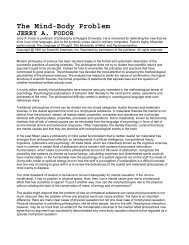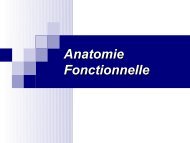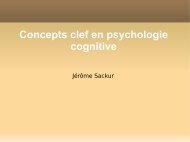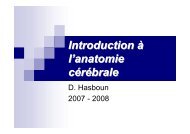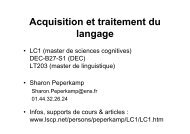From single to multiple deficit models of developmental disorders
From single to multiple deficit models of developmental disorders
From single to multiple deficit models of developmental disorders
You also want an ePaper? Increase the reach of your titles
YUMPU automatically turns print PDFs into web optimized ePapers that Google loves.
402 B.F. Penning<strong>to</strong>n / Cognition 101 (2006) 385–413<br />
4.2. Interactive processing<br />
Another <strong>multiple</strong> deWcit view <strong>of</strong> dyslexia comes from connectionist <strong>models</strong> <strong>of</strong><br />
<strong>single</strong> word reading. These <strong>models</strong> have certainly produced surprises for <strong>single</strong><br />
deWcit theories <strong>of</strong> dyslexia syndromes. When Hin<strong>to</strong>n and Shallice (1991) modeled<br />
deep dyslexia, the a priori prediction was that semantic errors would be<br />
produced by damage <strong>to</strong> a particular component <strong>of</strong> the network. Instead, it turned<br />
out that damage practically anywhere in the network produced such errors because<br />
<strong>of</strong> the interactive nature <strong>of</strong> the processing involved in going from print <strong>to</strong><br />
semantics.<br />
A similar conclusion was reached for errors in reading pseudowords and exception<br />
words, respectively, in the application <strong>of</strong> connectionist <strong>models</strong> <strong>to</strong> dyslexia subtypes<br />
(Manis, Seidenberg, Doi, McBride-Chang, & Petersen, 1996). Each error type<br />
is the hallmark <strong>of</strong> a diVerent dual-process subtype <strong>of</strong> <strong>developmental</strong> dyslexia (i.e.,<br />
phonological vs. surface) and is thought <strong>to</strong> reXect damage <strong>to</strong> distinct mechanisms<br />
(e.g., Temple, 1985a, 1985b). What Manis et al. (1996) demonstrated was that<br />
although the network could be altered in diVerent ways <strong>to</strong> produce each subtype,<br />
these alterations did not produce clean dissociations. An alteration that mainly<br />
aVected exception word reading also impacted the accuracy <strong>of</strong> reading pseudowords<br />
and vice versa. Once again the interactive nature <strong>of</strong> network dynamics is<br />
responsible.<br />
Drawing on this connectionist work, Snowling and colleagues (Snowling, 2002;<br />
Snowling et al., 2000) have proposed a <strong>multiple</strong> deWcit model that has many similarities<br />
<strong>to</strong> the <strong>multiple</strong> deWcit model proposed here. Based on the connectionist<br />
<strong>models</strong> <strong>of</strong> normal and abnormal reading developed by Seidenberg and colleagues<br />
(Harm & Seidenberg, 1999; Plaut, Seidenberg, McClelland, & Patterson, 1996;<br />
Seidenberg & McClelland, 1989), these researchers emphasized the interactive<br />
nature <strong>of</strong> reading development. In their view, a strength in semantic codes may<br />
oVset a phonological deWcit, so it is the interaction <strong>of</strong> <strong>multiple</strong> cognitive fac<strong>to</strong>rs<br />
that determines whether one has dyslexia. They also used this model <strong>to</strong> understand<br />
poor comprehenders, who are normal at decoding <strong>single</strong> printed words but<br />
impaired in reading comprehension, and <strong>to</strong> criticize the severity hypothesis discussed<br />
earlier because it only focuses on one component <strong>of</strong> the several that interact<br />
in reading.<br />
4.3. Unitization and au<strong>to</strong>maticity<br />
The double deWcit model (Bowers, 1993; Wolf & Bowers, 1999) proposes a nonphonological<br />
cause <strong>of</strong> RD. Similar <strong>to</strong> other subtyping <strong>models</strong>, this model proposes<br />
two <strong>single</strong> cognitive deWcit subtypes <strong>of</strong> RD, the familiar phonological deWcit subtype<br />
and a new, naming-speed deWcit subtype. Dyslexics with both deWcits have a “double<br />
deWcit” and are predicted <strong>to</strong> have more severe reading problems than those found in<br />
either <strong>single</strong> deWcit subtype, although the model is not explicit about whether the<br />
joint eVects <strong>of</strong> the two deWcits are additive or interactive. It is well documented that<br />
groups with RD perform poorly on measures <strong>of</strong> rapid serial naming and that such



